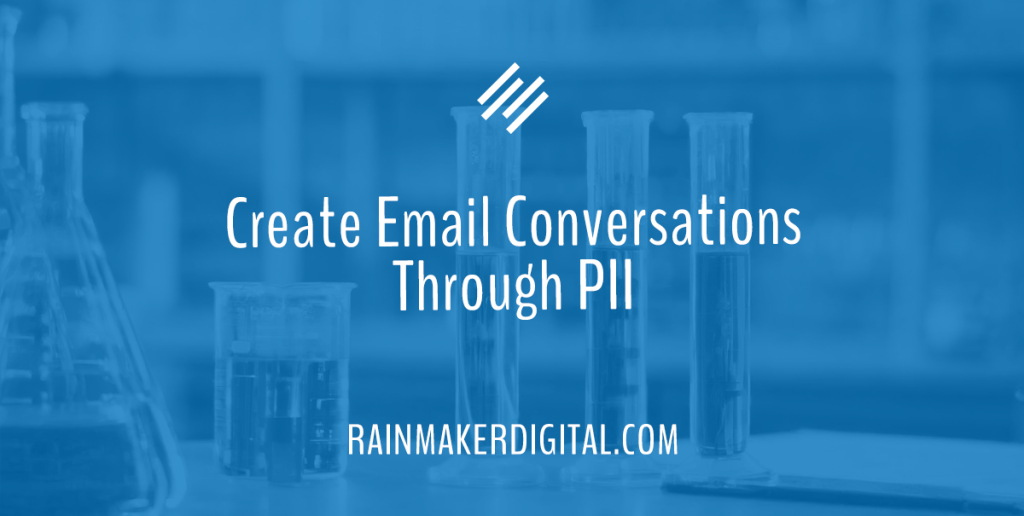
Email is the most important digital marketing channel you have.
Just like real life, relationships are built through one-on-one conversations over time. Communicating directly with your audience through a channel you control is the single most effective way to build a relationship.
The key word there is conversation.
If you talk about the same things every time you meet one of your friends, you probably won’t stay friends long. Talk about yourself and what you want too much? You come off like a pushy used car salesman in a cheap suit. Infodump? You sound like the one guy who’s really into trains and doesn’t realize no one else is interested. Too much inspiration and you sound like the burned-out stoner who really thinks they’re a philosopher.
Conversation requires a mix of content to build connections. Not every relationship is the same; not every message is either. That’s where PII™ comes in — short for Promotion, Information and Inspiration. Here’s how to use PII as an email marketing framework for different Internet businesses.
Start By Building Rapport
Pictured: an email marketer who doesn’t know how to mix up the conversation.
When we send marketing emails, we’re trying to build rapport with our audience. We do this by showing them that we’re on the same page as them. Psychologists call this a generalized shared reality. When you feel an immediate connection to someone, that’s that feeling. You’re discussing things you both care about, and you share viewpoints on them.
As one study on the subject notes, “Colloquial descriptions of relationship initiation often invoke the idea of “clicking” … we found that SR-G [generalized shared reality] predicted “clicking” between strangers, as well as closeness, rapport, and the desire to interact again.”
In other words, creating strong content that matches your audience’s worldview allows you to build a rapport with them.
Consider who your audience is. What do they care about? What gets them out of bed in the morning? What are their pain points and opportunities? Every piece of content you write (no matter which part of PII it is) needs to have that understanding. For more on this, see our piece “‘Who’ Comes First: Why Finding Your Audience Matters.”
A variety of content helps you connect to that audience. Being a bore about one subject will get people to tune you out. By varying your content, telling your story through a mix of content and matching it to the audience, you create that generalized shared reality.
What Does PII Mean?
PII is shorthand for the three elements your marketing mix needs to be successful.
- Promotion: Content that drives action. Often sales-related, but not always — could be signups for a webinar, social follows, eBook download, 50% off coupon, signup for a private event or any number of other actions. The key is telling people what you want them to do.
- Information: Content that educates. This is where you share knowledge about your niche — blogs, podcasts, newsletters that give your audience information that’s useful to them. You need to share information that demonstrates you’re worth the audience’s interest and belief in you. That means showing yourself an authority on the topic they’ve connected to your brand.
- Inspiration: Content that creates emotion. Emotion, not logic, is the main ingredient to bring you and your audience closer — personal updates and motivational pieces are good examples. All relationships are fueled by emotion; people can believe you’re authoritative, but for them to really engage with you, they have to like you. You need to make sure that you’re contributing emotional energy to the relationship.
Every piece of content will fall into one of these three categories; it may fall into more than one, especially if your email is more newsletter-style and includes multiple elements.
Why Does PII Matter?
If you miss any element of PII, you’re not going to be successful.
Think about the most interesting people you like to talk to. They can hold conversations across several different topics, and they’ll adjust what they say to the situation and the audience to maintain that “generalized shared reality.” PII gives you a framework to do the same thing in your email marketing — give them the right mix.
What’s the Right PII Mix for Your Business?
Every audience needs a different mix of content. Here are some classic starting points you can use based on your business model:
- Retail: 40% promotion, 30% information, and 20% inspiration
- B2B: 20% promotion, 50% information, and 30% inspiration
- Consumer Services: 35% promotion, 25% information, and 40% inspiration
- Professional Services: 10% promotion, 60% information, and 30% inspiration
- Online Business: 40% promotion, 30% information, and 30% inspiration
Keep an eye on your open rates and click-through rates over time and see what content performs best; adjust your PII mix accordingly.
We’ve seen an increase in the effectiveness of inspirational content over the last few years; be ready to bump up the inspiration, especially in B2B. Audiences are tired of being blasted with information and calls to action. Don’t overdo promotion; it’s the fastest way to burn out your audience.
The content mix may be on an email-by-email basis (for example, discrete sales emails, personal updates and industry blog broadcasts) or within the same email (newsletter with multiple parts). Either works. Garbage Day, one of my favorite newsletters, follows the latter format and has been very successful.
Create Conversations
If you want to create conversations with your audience, you must offer them a good mix of useful content. Use PII to figure out your unique content mix. Build rapport with your audience by talking about what they want to hear, and they’ll be more receptive to you.
Need a hand? We build strategies for brands like yours all the time. Just drop us a line, anytime.
Best Regards,
David Brandon
Copywriter
Rainmaker Digital Services
